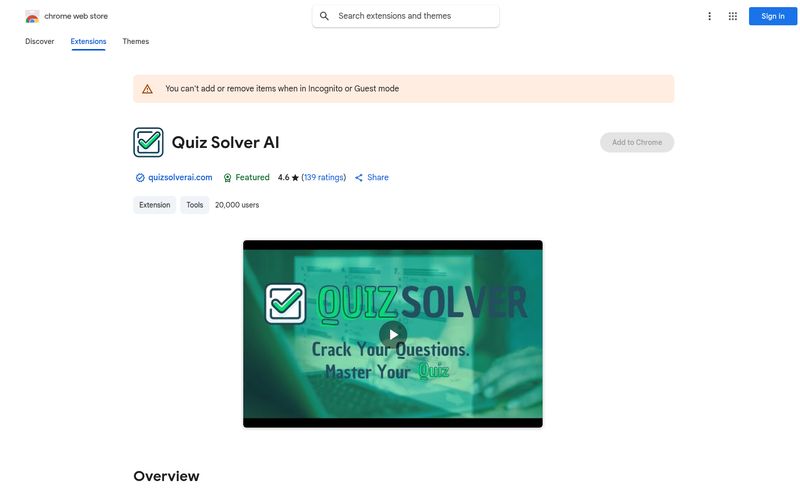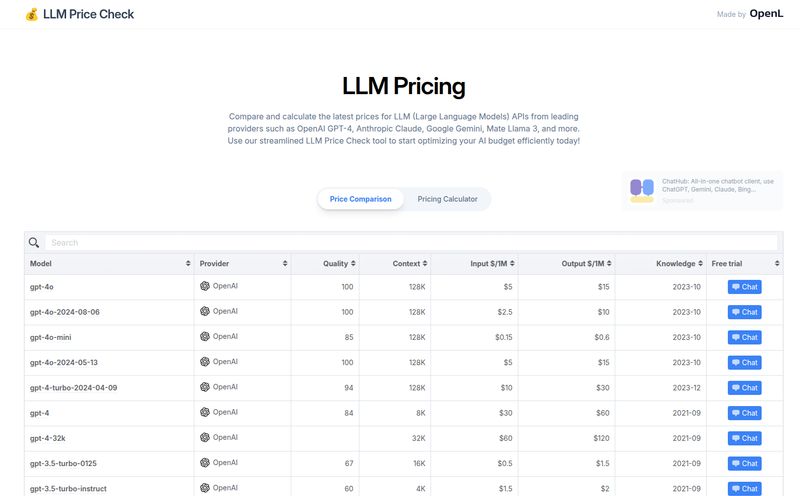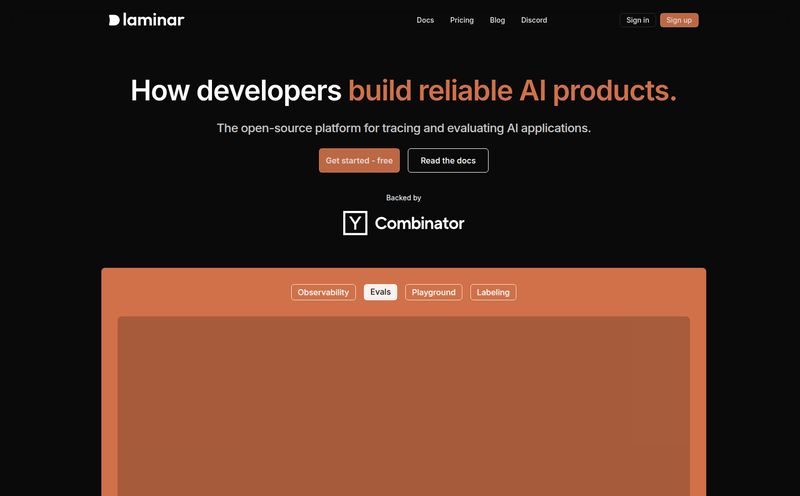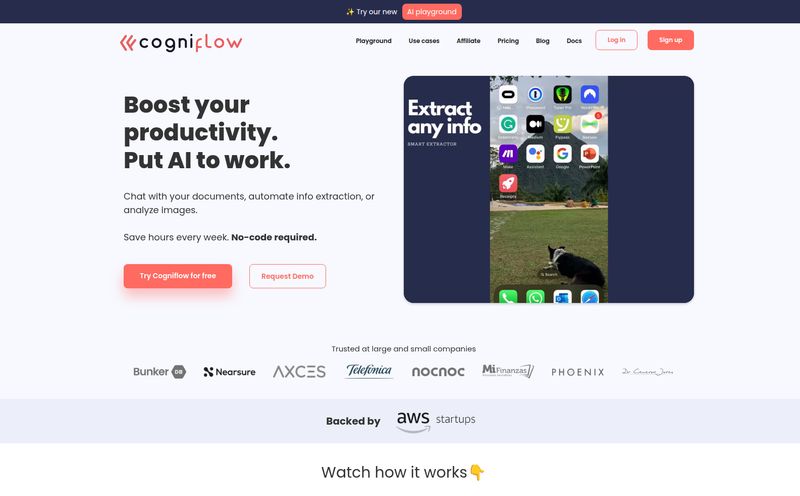Data annotation. Just the phrase can send a shiver down the spine of any data scientist or ML engineer. It’s the unglamorous, behind-the-scenes grunt work of the AI world. It’s tedious. It's manual. It’s the digital equivalent of sorting a million tiny, identical screws by hand, hoping you don't go cross-eyed.
We've all been there. Staring at a mountain of free-text, coffee going cold, wondering if this is what the AI revolution was really supposed to feel like. For years, we've had tools that helped, sure, but most were little more than glorified highlighters. You still had to do all the thinking, all the repetitive labeling, until your brain felt like mush.
Then, every once in a while, a tool comes along that makes you sit up and pay attention. A tool that doesn’t just help you do the work, but actively works with you. I think I've found one of those tools. It's called Markup, and it's an open-source annotation tool with a GPT-4 brain. And frankly, it might just change how we feel about data annotation for good.
What Exactly is Markup?
Let's get the jargon out of the way. Markup is an open-source annotation tool designed to transform messy, unstructured documents into clean, structured formats that machine learning models can actually understand. Its bread and butter is Natural Language Processing (NLP) tasks, like the ever-important Named-Entity Recognition (NER).
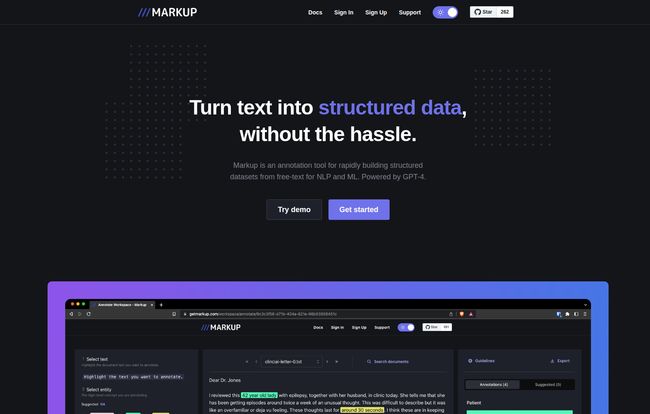
Visit Markup
But what does that mean in plain English? Think of it this way: you have a thousand pages of doctors' notes. A chaotic sea of text. You need your AI to find every single mention of a patient's name, their prescribed medication, the dosage, and any adverse reactions. Doing that manually is a nightmare. Markup is designed to make that process not just easier, but smarter.
It's like having a super-intelligent research assistant. You highlight a piece of text—say, “sodium valproate 500 mg twice a day”—and you don't just label it 'Prescription'. Markup lets you add attributes, like 'Drug Name', 'Dosage', and 'Frequency'. It turns a simple label into a rich, structured piece of data. This isn't your grandpa's data labeler; we're way past simple bounding boxes for cat pictures here.
The Magic Ingredient: How GPT-4 Changes the Game
Here’s where it gets really interesting. The headline feature, the thing that sets Markup apart from the crowd, is its integration with GPT-4. It doesn't just sit there waiting for you to do all the work. Markup learns as you annotate.
After you’ve labeled a few examples, it starts to understand the patterns. It then begins to predict and suggest annotations for the rest of your document. See a patient's name? Markup will likely highlight it and suggest the 'Patient' entity before you even have to. It's proactive. The more you use it, the better it gets, turning a monotonous task into a supervisory one. You become an editor, approving and correcting the AI's suggestions, rather than being the assembly line worker yourself.
I’ve used a lot of annotation tools over the years, from open-source classics like Prodigy to big enterprise platforms. The leap from a purely manual tool to an AI-assisted one is massive. It's the difference between digging a ditch with a shovel versus using an excavator. Both get the job done, but one does it faster, more efficiently, and with a lot less back-breaking labor.
A Walkthrough of the Markup Interface
Looking at the tool, the interface is clean. It’s dark mode by default, which my eyes are thankful for. On the left, you have your annotation workflow: select text, pick an entity, add attributes. On the right, you see your existing annotations and the AI's suggestions. It's intuitive. There's no clutter, no confusing array of a hundred buttons. It's focused on the task at hand.
The example in their demo, which appears to be a clinical letter, is a perfect use case. You can see it identifying a "Patient" (a 62 year old lady), a "Prescription," a "Doctor," and even a "Hospital." This is precisely the kind of complex, multi-entity extraction that is incredibly valuable in fields like healthcare and legal tech. The fact that they list the NHS and SAIL Databank as partners on their homepage really drives this point home; this tool is built for serious, real-world applications.
The Good, The Bad, and The Code
No tool is perfect, of course. So let's break it down with a bit of my own perspective.
Why I'm Genuinely Excited About Markup
First off, the open-source aspect is a huge win. In an era where every useful AI tool seems to be locked behind a hefty subscription, having access to the source code is a breath of fresh air. It means a community can build around it, extend it, and adapt it. You’re not at the mercy of a single company’s product roadmap. You can find it and star it on GitHub right now.
And I can't say it enough: the GPT-4 predictive power is the killer feature. Data preparation is the biggest bottleneck in most ML projects. Some studies suggest it takes up to 80% of a data scientist's time. In my book, any tool that can slash that time is worth its weight in gold. Markup feels like a gold mine.
A Few Things to Keep in Mind
On the flip side, there are a couple of things to be aware of. The documentation lists that it "Requires JavaScript to run." Honestly, in 2024, this is a non-issue for virtually everyone, but it's a technical dependency worth noting. It’s not a standalone desktop app you can run in a vacuum.
More importantly, they mention a potential "learning curve." I actually see this as a positive. It’s not Candy Crush; it's a professional tool for a complex task. You should expect to spend a little time getting familiar with its workflow and how to best guide its AI. Powerful tools require a bit of skill to wield effectively, and that's okay. It separates the serious practitioners from the dabblers.
What's the Price? The Best Things in Life are...
So, what’s the damage to your wallet? This is my favorite part. As an open-source tool, you can self-host it for free. You'll have to manage the setup and any server costs yourself, but the software itself is free to use.
In my search for more info, I tried to find a pricing page. The link was empty. Instead, I landed on a 404 page that said, "You have found a secret place." I have to say, I love a company with a sense of humor. It tells me there are real people behind the curtain who don't take themselves too seriously. A very good sign.
Who is Markup Actually For?
Markup isn't for everyone. If you just need to draw boxes around cats, it’s probably overkill. But if you're a data scientist, an NLP researcher, a machine learning engineer, or an academic working with dense, unstructured text, this tool should be on your radar.
It’s for the teams building custom chatbots that need to understand user intent. It's for the legal-tech firms trying to extract clauses from contracts. It’s for the medical researchers trying to find trends in millions of patient records. It’s for anyone who needs to build a high-quality, bespoke dataset from text without losing their sanity in hte process.
So, Should You Give Markup a Try?
If you're in the NLP or ML space and the words "unstructured data" are part of your daily vocabulary, my verdict is a resounding yes. The combination of a clean, focused interface, the game-changing power of GPT-4-assisted annotation, and the freedom of an open-source license is a potent mix.
This is one of those tools that feels like it’s on the cusp of becoming an industry standard. It’s smart, it’s practical, and it solves a very real, very painful problem. Go check out the demo, star their GitHub, and see for yourself. You might just start to enjoy data annotation. Okay, maybe that's a stretch, but you'll definitely hate it a whole lot less.
Frequently Asked Questions about Markup
- What is Markup primarily used for?
- Markup is designed for transforming unstructured text documents into structured data for machine learning. Its main use case is for NLP tasks like Named-Entity Recognition (NER), classification, and creating high-quality datasets for training AI models.
- Is Markup a free tool?
- Yes, Markup is open-source. This means the software is free to use, modify, and distribute. You would typically self-host it, so you'd only be responsible for any server or infrastructure costs you incur.
- What makes Markup different from other annotation tools?
- Its key differentiator is the integration of GPT-4. Markup learns from your annotations in real-time to predict and suggest new labels, significantly speeding up the workflow and reducing manual effort compared to traditional, non-AI-assisted tools.
- Do I need to be a programmer to use Markup?
- While the user interface is designed to be friendly, setting up an open-source tool often requires some technical know-how. There might be a slight learning curve to use it most effectively, but deep programming knowledge isn't required for the annotation process itself.
- What kinds of data can I annotate with Markup?
- Markup is built for unstructured text. This includes things like emails, customer support tickets, legal documents, scientific papers, social media posts and medical records.
- Is Markup difficult to set up?
- As with most self-hosted, open-source tools, the setup will be more involved than a simple cloud-based SaaS product. You'll need to follow the installation instructions on their GitHub page, which may require some comfort with the command line and server environments.
Reference and Sources
- Markup Official Website
- Markup GitHub Repository
- Prodigy Annotation Tool (For comparison)
- What is Named-Entity Recognition (NER)? by TechTarget
